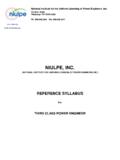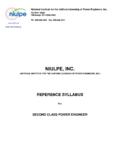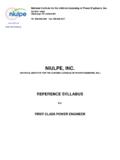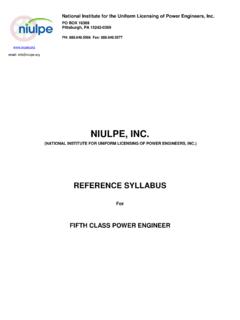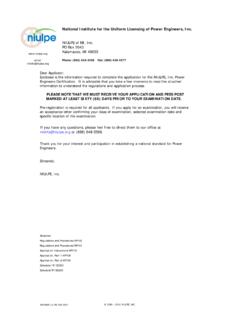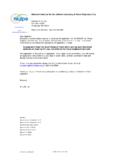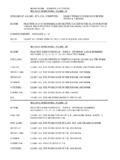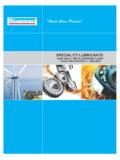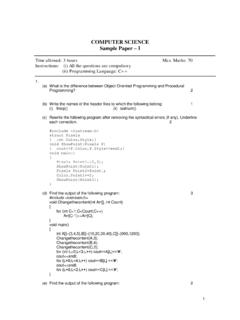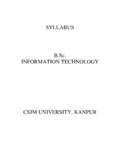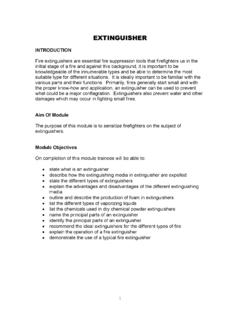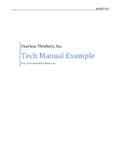Transcription of NIULPE PE 4th Class R8 091009
1 NIULPE , INC. (NATIONAL INSTITUTE FOR UNIFORM LICENSING OF POWER ENGINEERS, INC.) REFERENCE SYLLABUS For FOURTH Class POWER ENGINEER email: The National Institute for the Uniform Licensing of Power Engineers, Inc. PO BOX 16369 Pittsburgh, PA 15242-0369 PH: Fax: 06-103 R9 09/10/09 2005 2009 NIULPE , INC. Page 2 of 5 Introduction This syllabus has been approved by the NATIONAL INSTITUTE FOR UNIFORM LICENSING OF POWER ENGINEERS, INC. ( NIULPE ) This Syllabus is intended to assist candidates studying for the Fourth Class Power Engineer Examination. Recommended Study Program: It is recommended that, before undertaking this examination, the candidate completes the Fourth Class Power Engineering Course offered through a recognized technical institute or training provider.
2 In addition to the foregoing course, it is recommended that the candidate becomes familiar with the publications listed in the Reference Material for Power Engineering Students and Examination Candidates, which is obtainable from the various technical institutes or from the NIULPE Website. 06-103 R9 09/10/09 2005 2009 NIULPE , INC. Page 3 of 5 REFERENCE SYLLABUS FOR FOURTH Class EXAMINATION CANDIDATES 1, Elementary Mechanics and Dynamics a) Definitions of mechanical properties, moments and forces, simple machines, mechanical advantage, scalars and vectors, linear velocity and acceleration; force, work, pressure, power and energy, friction, stress and strain, factor of safety, power transmission 2, Elementary Thermodynamics a) Basic thermodynamic concepts, temperature and thermal expansion, specific, sensible and latent heat, thermodynamics of steam, steam tables, interpolation, basic chemical and physical properties 3, Plant Safety a) Costs and effects of workplace injuries b) Personal protective equipment c) Isolation of mechanical and electrical equipment d) Confined space entry e) Handling of gases and hydrocarbon fluids f) Hydrogen sulphide safety g) First aid, CPR and artificial respiration h) Safety Committees 4, Piping and Valves a) Materials.
3 Sizes and identification b) Piping, pipe fittings and connections c) Expansion joints, bends, support, hangers and insulation d) Drainage; separators, traps, water hammer e) Valve types; construction and application 5, High Pressure Boiler Design a) Development of boiler design b) Boiler terminology c) Firetube boilers; construction, stays, tubes, tube sheets, shell d) Watertube boilers; construction, drums and walls e) Electric boilers f) Boiler construction; support, suspension, refractory 6, High Pressure Boiler Parts and Fittings a) Combustion theory, composition of fuel, fuel heating value b) Boiler draft equipment; natural, forced, induced, balanced c) Boiler combustion equipment; coal, oil and gas burners and safety d) Fluidized bed and grate systems e) Safety and relief valves f) Water columns and gauge glasses g) Steam Drum Internals h) Superheaters, reheaters, economizers, air heaters i) Insulation 7, High Pressure Boiler Operation a) Boiler pre-start, start-up, operation and shut-down b) Emergency boiler operation c) Soot blowers d) Continuous and intermittent blowdown 06-103 R9 09/10/09 2005 2009 NIULPE , INC.
4 Page 4 of 5 e) Chemical and mechanical cleaning, boil out and lay-up f) Hydrostatic testing, inspection, safety precautions g) Cause and prevention of boiler furnace explosions 8, Feedwater Treatment a) External feedwater treatment; filtration, lime soda, zeolite, deaeration b) Internal feedwater treatment and testing c) Knowledge and control of: pH, sludge, scale, foaming, caustic embrittlement, blow-down and corrosion 9, Prime Movers and Engines a) Heat engines, prime mover terminology b) Simple steam engine; construction, details, operation and maintenance, lubrication c) Steam turbines; construction, impulse, reaction, governing, overspeed trip, lubrication, start-up, operation, shut-down d) Cooling towers, condensers e) Basic gas turbines; construction, applications, open cycle, regeneration, steam and gas turbine plants f) Internal combustion engines; construction, working cycles, fuels, lubrication, start-up, operation, shut-down 10, Pumps and Compressors a) Pumps i) Pumping theory ii) Pump operation and maintenance iii) Reciprocating pumps; simplex, duplex, valves, drivers iv) Centrifugal pumps; volute, diffusers, impellers, wear rings,seals, packing, start-up, operation and shut-down v) Turbine pump, rotary pump b) Air Compression i) Theory, altitude, barometers ii) Reciprocating compressors.
5 Construction, stages, cooling components, valves, control, lubrication and operation iii) Axial; construction, components, lubrication and operation iv) Systems; receivers, intercoolers, aftercoolers, driers, moisture, safety devices 11, Lubrication a) Lubrication; principles, lubricants, classes, viscosities, applications, systems b) Bearing lubrication; operation, maintenance, failure 12, Electricity a) Electrical; terms, properties, measurement and calculations b) Power and work c) Magnetism and electromagnetism d) Electrical metering devices; voltmeters, ammeters, wattmeters e) Conductors, insulators f) Motors and generators: AC and DC, operation g) Transformers h) Electrical distribution circuits, breakers, switches, fuses i) Safe operation 13, Controls, instrumentation and computers a) Instrumentation terms and definitions b) Methods of process measurement c) Basic control loop components d) Basic boiler instrumentation and control systems, gauges 06-103 R9 09/10/09 2005 2009 NIULPE , INC.
6 Page 5 of 5 e) Low water fuel cut-offs, mercury switch, thermocouples f) Boiler programming controls g) Types of computers; principles, software programs, languages, applications, components h) Introductory process computer concepts i) Input and output devices, data recording and storage 14, Heating Boilers a) Watertube and tubular heating boilers b) Cast iron sectional and modular heating boilers c) Firetube heating boilers d) Oil and gas burners for heating boilers e) Steam heating boiler fittings, attachments and auxiliaries f) Hot water heating boilers; fittings, attachments g) Hot water and steam heating boiler operation and maintenance h) Cleaning, inspection, lay up, safety 15, Heating Systems a) Steam heating auxiliaries; radiators, convectors, unit heaters, coils, ventilators, air vents, valves, traps, vacuum pumps b) Steam heating systems; operation and maintenance c) Hot water heating auxiliaries; pumps, controls, valves, expansion tanks, converters, radiant panels, snow melt d) Hot water heating systems.
7 Operation and maintenance e) Warm air heating system equipment f) Warm air furnace components and maintenance: furnaces, humidifiers, air distribution, trouble shooting g) Ventilation and air filters h) Infrared and electric heating 16, Heating Boiler and Heating System Controls a) Heating boiler feedwater controls b) Heating boiler operating controls c) Heating boiler combustion controls d) Pneumatic controls for heating systems e) Electric controls for heating systems f) Electronic controls for heating systems, indoor, outdoor, multi-zone, advantages, disadvantages 17, Vapor Compression Refrigeration a) Safety, b) Thermodynamics of Refrigeration c) Properties of Refrigerants d) Compression refrigeration systems; components, auxiliaries, relief devices e) Refrigeration compressor components f) Heat exchangers for refrigeration systems g) Refrigeration metering devices and capacity controls h) Refrigeration cycle controls i) Refrigeration system accessories j) Compression refrigeration system pre start-up, start-up, operational checks and procedures, shut-down k) Compression refrigeration system maintenance, testing, charging, surging, trouble shooting
